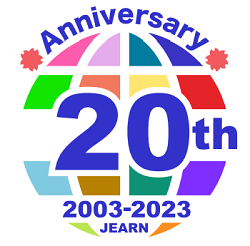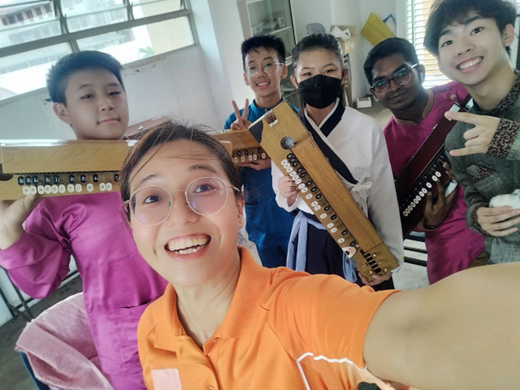 |
|
Article Series |
|
| "Real Voices" No.12 Malaysia |
|
|
|
|
|
|
| Connecting the World! Teachers' Network News |
| Real Voices of iEARN Teachers Around the World |
The year 2023 marks the 20th anniversary of JEARN established as an official NPO in Japan.
To celebrate this memorial year, JEARN launched a monthly interview series "Real Voices" to deliver
the real voices of iEARN teachers from around the world. Each article introduces
school systems of each country and region, daily efforts of teachers and
staff, and the development of students for global competence and citizenship. |
|
Lim Wen Li
iEARN Teacher
SMK Sultan Abu Bakar School, Pahang, Malaysia,
|
Holding calligraphy words during a Chinese
New Year event in school. It means,
"pray for a peaceful and joyous world"
|
| Ms. Lim Wen Li from Malaysia |
|
| What school or organization are you working at? If you are a
teacher, how many years of experience do you have as a teacher?
|
I
am working in SMK Sultan Abu Bakar School. This is a premier school due to its
excellence result in academic and co curriculum. It was established in year
1957 and it is located at the center of the town. This school is consists of
three main races. Malays Chinese and Indians. Hence it is rich in different
cultures. It has around 1000 students and it follows the standard subjects and
facilities provided by the government.
I
have 13 years of experience as a teacher. I am teaching pre university students
for the mathematics technology subject.
|
| What is the compulsory education system in your country? At what age does compulsory education start
and end?
|
|
Malaysia
education system is structured. It has 5-6 years old for preschool. 7-12 years
old for primary school. 13-17 years old for secondary school and 18-19 years
old for pre university students. Students in secondary school are learning 9-10
subjects.
Malaysians
communicate with each other using a variety of languages and communication
styles due to the country's multicultural and multilingual society. The main
languages spoken in Malaysia are Malay (official language), English, Chinese
(Mandarin and various Chinese dialects), and Tamil. Here are some key aspects
of communication in Malaysia:
| Language Diversity: Malaysians often switch between languages based on
the context and the people they are communicating with. Malay, also known
as Bahasa Malaysia, is commonly used for official purposes, in government,
and in education. English is widely used, especially in business and education.
Chinese dialects such as Mandarin, Hokkien, and Cantonese are spoken among
the Chinese community, while Tamil is spoken among the Indian community.
|

Having a wefie session with my students after the Taisho Koto performance
at school
|
This linguistic diversity can create a rich tapestry of communication but can also lead to challenges in understanding if individuals do not speak the same language.
Language Diversity: Malaysians
often switch between languages based on the context and the people they are
communicating with. Malay, also known as Bahasa Malaysia, is commonly used for
official purposes, in government, and in education. English is widely used,
especially in business and education. Chinese dialects such as Mandarin,
Hokkien, and Cantonese are spoken among the Chinese community, while Tamil is
spoken among the Indian community. This linguistic diversity can create a rich
tapestry of communication but can also lead to challenges in understanding if
individuals do not speak the same language.
Code-Switching:
Malaysians are known for code-switching, which involves mixing different
languages within a single conversation. This code-switching can be used for
emphasis, to express cultural identity, or to include words that are better
suited for a particular context. For example, a conversation may start in
Malay, switch to English for technical terms, and incorporate Chinese or Tamil
words for cultural references.
Interfaith
and Intercultural Understanding: Malaysia is a diverse nation with a mix of
Malay, Chinese, Indian, and indigenous cultures. While this diversity can be
enriching, it can also lead to challenges related to intercultural
understanding. Issues related to religion, customs, and traditions may
sometimes create misunderstandings or tensions. However, many Malaysians have a
strong sense of unity and multiculturalism, which helps foster intercultural
understanding and tolerance.
Classroom
Dynamics: In the classroom, Malaysian students often come from different
cultural and linguistic backgrounds. Teachers and students may need to navigate
these differences in order to create an inclusive and effective learning
environment. Teachers are generally trained to be sensitive to cultural
diversity and may use various teaching strategies to accommodate students from
different linguistic backgrounds.
In summary, communication in Malaysia is characterized by linguistic diversity, code-switching, and an appreciation for nonverbal communication. While there can be challenges related to intercultural understanding, Malaysians generally value their multicultural heritage and work towards fostering unity and tolerance in their society, including within classrooms and educational institutions
|
| When does the school year start and end in your country?
|
Currently, we start the school in March and ends in February. Government plans to adjust it back to January in
the year of 2025.
|
| What are some of the options for your students after they
graduate? Do they typically go on to universities or vocational schools? Or do
some of them pursue professional careers?
|
After
Malaysian students complete their secondary school SPM (Sijil Pelajaran
Malaysia), they have several options for their future education and career
paths. The choice often depends on their interests, academic performance,
financial resources, and career aspirations. Here are some of the common
options:
Pre-University
Education: Many students choose to pursue pre-university education after SPM to
prepare for university entrance. Common pre-university programs in Malaysia
include the Malaysian Matriculation Program, A-Level, International
Baccalaureate (IB), and the Malaysian Higher School Certificate (STPM). These
programs provide students with the necessary academic foundation to gain entry
into local or international universities.
Local
Universities: A significant number of SPM graduates go on to enroll in local
public universities, known as public higher education institutions (HEIs).
These universities offer a wide range of degree programs, and admission is
typically based on academic performance and the specific requirements of each
program.
Private
Universities and Colleges: Malaysia has a robust private higher education
sector, and many students choose to study at private universities and colleges.
These institutions offer various programs and often provide flexible study
options, including part-time and online courses.
Vocational
and Technical Education: Some SPM graduates opt for vocational or technical
education to acquire practical skills and qualifications for specific careers.
Institutions such as vocational colleges and technical training centers offer
programs in fields like automotive technology, culinary arts, electrical
engineering, and more.
Professional
Qualifications: Some students pursue professional qualifications directly after
SPM. For example, they may enroll in programs to become certified accountants
(e.g., ACCA), engineers (e.g., BEM), or medical assistants (e.g., Diploma in
Medical Assistant). These qualifications allow them to enter the workforce in
specific professions.
Scholarships
and Financial Aid: Scholarships and financial aid programs are available to help
SPM graduates pursue higher education. Both government and private
organizations offer scholarships and grants based on academic merit, financial
need, or specific criteria related to the field of study.
Workforce
Entry: While many SPM graduates choose to continue their education, some opt to
enter the workforce directly after completing SPM. They may take on entry-level
jobs in various industries, gain work experience, and then decide whether to
pursue further education later.
The
choice of educational pathway can vary widely among Malaysian students, and
there is no one-size-fits-all approach. Some may start with vocational training
and then pursue a university degree, while others may choose to work and gain
experience before returning to school. The decision depends on individual goals
and circumstances.
|
| How many years of experience do you have in iEARN? What iEARN projects have you
done with your students?
|
| I have a year experience with iEARN project. This year, I have done an air filter system with my students to solve the haze problem in Malaysia. |
| My favorite part of this project would be the bottleneck part. It is made of recycled items. And therefore it is economical yet effective. We have innovated a project named Airpurecool to solve the haze problems which currently happen in Malaysia. This Airpurecool is made by plastic bottlenecks using Joule-Thomson Effect and Charles Law. The system works as follows: the hot air that enters each bottle is compressed around the neck of the bottle, cooling it down before it enters the room. The neck of the bottle acts as a tunnel that compresses the air. |

My iEARN project teams in 2023
|
| This cools the air when it exits the neck of the bottle (rapid expansion) using the same principle. The cooling effect following rapid expansion is known as the Joule-Thomson effect. Depending on the direction of the wind and the pressure exerted, the Airpurecool can reduce the temperature by four degrees, which is about the same amount as an electric air conditioner. This project is made of all recycled items and hence it is economically and environmentally friendly.
|
| Regarding the use of
ICT, is One-to-One PC being done in your school? Do your students take those
devices home? Do you use them for online classes? |
After the pandemic, students can use
technology better in class or at home. They are able to find the answers for a
problem by themselves. There's increase use of education technology in class.
I have used xp pens, projectors, tablets in
class. The same goes to my students. Google classroom, Quizz Izz, Class Point,
are the apps that I used often in class. |

One of my students using a tablet to sketch graphs and do some quizzes
for classroom activities
|
| The most significant advantages of
making use of technology in teaching is students can focus more in the class.
The lessons are more engaging and dynamic. By introducing technology to formal education,
students might have more screen time which might affect their eyes. Also, with
the existing of Chat GPT, students might not think but just copy the answers
from the website. |
|
|
|
*****
The iEARN Teacher interviews are part of a series of articles by JEARN
entitled "Connecting The World! Teachers Network News" starting
with the January 2023 issue in a Japanese monthly magazine for educators, Cresco
(Otsuki Shoten Publishers here). |
|
|

Nonprofit Organization JEARN
|